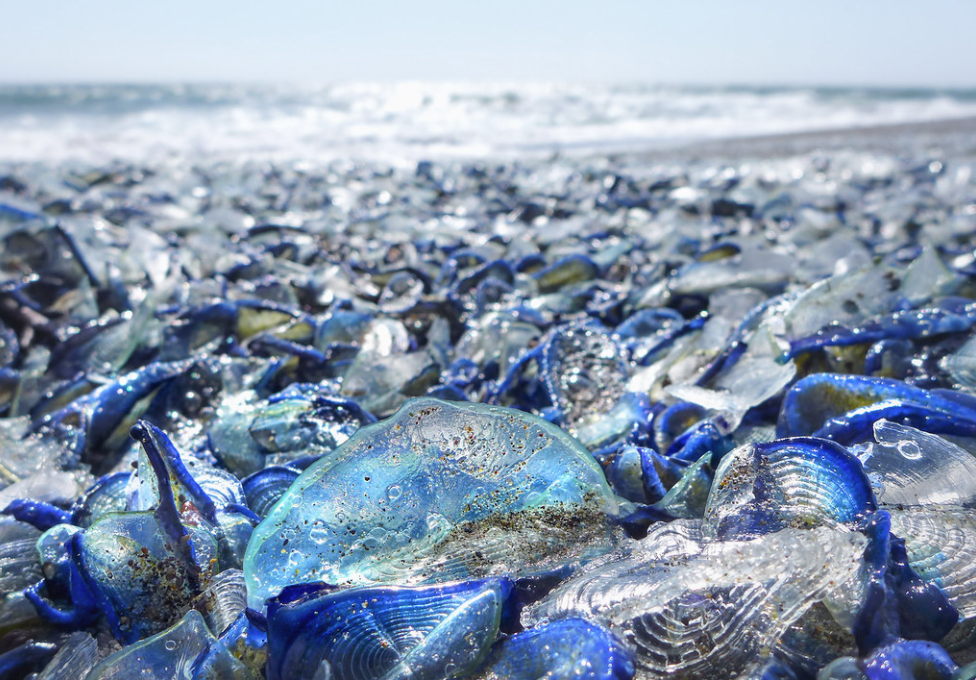Creature Feature: By-the -Wind Sailors Velella velella
Creature Feature: By-the-Wind Sailor Velella velella
Thousands of by-the-wind sailors washed ashore after a wind too strong to “sail” against. Photo by Ingrid Taylar, Creative Commons.
Teamwork makes the dream work in colonial animals
By-the-wind sailors, or Velella velella, look like they might be jellyfish, but are actually kiwi-sized colonies of critters. Yep, what looks like one animal is actually several parts, or polyps, strong. Some polyps are specialized for stinging prey and others for digesting it.
Nettles in the sea?
By-the-wind sailors belong to the class hydrozoans, part of the same stinging cell-armed sea creatures group as jellyfish, Cnidarians (look up the root word, cnidos, in Greek. What does it mean?). Cnidarians include some critters you’ve likely seen: anemones, corals, box jellies, siphonophores (like Portuguese man-o-war), stalked hydroids, and both scyphozoan and hydrozoan jellyfish. If they have stinging cells, can they sting us? Luckily, their stinging cells, or nematocysts, are only potent enough to paralyze their planktonic prey! So feel free to investigate when you see them on the beach.
A by-the-wind sailor washed ashore, sand on its “sail” and color leaking out. The sail is positioned to let light winds push them away from shore, but it is no match for the heavy winds that shipwrecked this one. Photo by Jonathan Lidbeck Creative Commons.
Yo-ho-ho, A sailor’s life for me!
By-the-wind-sailors are especially known for their little “sail” that helps them move across the ocean surface using wind. The sail is made of a material containing chitin, which is the tough substance that gives structure to crab, insect, and lobster shells. The blue base (it looks like a fingerprint) is filled with tiny air sacs which help the little friend float. Interestingly enough, these creatures can actually be left or right handed (sailed?), leaning them one way more than the other as they sail! Their sails typically keep them in offshore, open waters with millions of others, but strong winds, currents, or storms can push them to make landfall here in the Salish Sea and other shores.
Learn how by-the-wind sailors grow, reproduce, and some really weird facts in this Monterey Bay Aquarium Research Institute video.
By-the-wind-sailors are in adult stage when you see them floating on the surface of the water. From here they live, feed, and reproduce.
Mini me
When they reproduce, they “bud off” little babies called medusae that are genetically identical to the parents. The medusae look like teeny jellyfish. Less than 2 mm long, that’s less than half the size of a grain of rice! These babies float around until they eventually morph into their adult sailor stage.
Paralyzing prey
Velella velella caught in a tidepool at Yaquina Head. Photo by Bureau of Land Management.
If you look closely at the bottom of each “sailor,” you’ll notice very tiny tentacles that hang into the water. It’s as if you flipped a sea anemone upside down! These tentacles capture small plankton and deliver it to the feeding polyps. Cnidarians don’t have a 1-way gut. The mouth and, well, the exit, are one and the same. Digest that!
Sun-fired symbiosis
What happens if they don’t catch any food floating around? These creatures have a backup plan. They live with a special algae (tiny plants) that provides a mutually beneficial relationship or symbiosis. The algae lives, protected in the sailor and eats the waste that the sailor produces. In return, the algae will turn sunlight into sugars that the sailor can use for energy. Mutualism for the win-win!
Sunblock on board
Because they hang out at the sea surface as grown-ups, they face many challenges. They can actually sunburn, like you on a sunny day at the beach. But bring on the rays! Velella have built-in blue pigment that helps block solar radiation that would otherwise cause them to crisp like a potato chip. The blue coloring also gives the animal some camouflage so that it will blend into its surroundings better to avoid being eaten.
Holy Mola mola!
Ocean sunfish, or Mola mola, a predator of Velella velella. Photo by Timothy Takemoto, Creative Commons.
Unfortunately, the sailor does sometimes end up as dinner. Two of its predators are the ocean sunfish (Mola mola) and purple snails (Janthina janthina). Two more ocean creatures so nice they named them twice! Blue dragon nudibranchs (Glaucus atlanticus) also snack on sailors (the invertebrate kind, not the Ahoy-there-matey, kind), taking more than just their lives. This floating sea slug creates a bubble in its belly that it uses to stay at the surface to catch its sailing prey. Then it arms itself with the stinging cells from the by-the-wind sailors it eats, which fill the tentacle-like cerrata on the slug’s back. Stolen defenses! Could they be stealing their fancy, blue sunscreen too?
Keep on sailin’, little sailors!
Like many other sea creatures, Velella velella depend on clean ocean water to grow, feed, and reproduce. Using non-toxic cleaners and lawn care products, checking cars for oil leaks, and making sure our community’s stormwater is filtered before entering the ocean all help improve water quality for by-the-wind sailors. Cutting plastics out of our shopping lists as much as possible can also help. Velella velella can accidentally consume tiny bits of floating plastic, which can affect their health and that of their predators, too, as the plastics make their way up the food chain.
Want to report sightings of a jellyfish or Velella velella to help scientists?? Go online to jellywatch.org or facebook.com/jellywatch. These are just a few ways to help our little sailors keep on sailin’!




